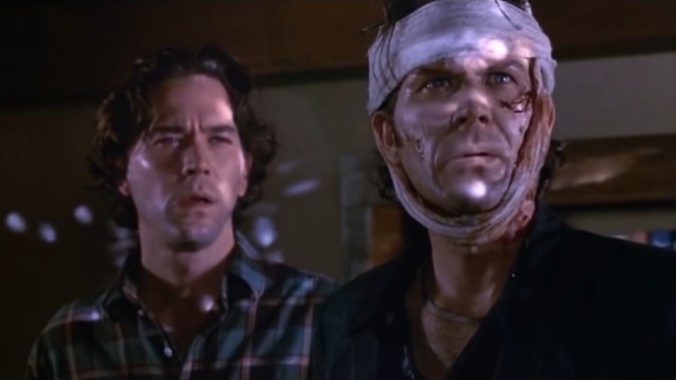The Other Stephen King and George Romero Classic: The Quiet Fury of The Dark Half

The late, great George A. Romero wasn’t a guy usually in the business of adapting someone else’s work for his features. His stories were his own, which only serves to highlight the particular kinship he seemed to feel with Stephen King. The pair bonded because they were fans of each other, then bonded further because they shared a love of gore-laden, darkly humorous EC Comics stories, which led to the anthology horror masterpiece Creepshow. King trusted Romero enough to let him not just adapt his stories, but to direct him in one memorably cartoonish Creepshow segment. Romero trusted King enough to let the author’s fiction be a road map for some of his best-known cinematic output.
For many horror fans, this partnership between two icons of the genre begins and ends with Creepshow and its sequel (less impactful than the original but still packed with outstanding stuff like “The Raft”). But King and Romero remained friends and mutual admirers, enough so that they managed to work together in a big way one more time, three decades later. Released this month back in 1993, The Dark Half has become the semi-forgotten King/Romero team-up movie, in part because it lacks the flash and genre-shifting impact of Creepshow, and in part because the film wasn’t nearly as warmly received as their previous work together. Take a look back at the film now, though, and you’ll find a fascinating merging of Romero’s cinematic sensibilities and King’s instinct-driven storytelling that holds up better than its reputation would suggest.
Inspired by King’s own alter ego, Richard Bachman, and what happened when King was outed as the author of books like The Running Man and The Long Walk, The Dark Half is yet another Stephen King story about a writer. In this case, it’s Thad Beaumont (Timothy Hutto), a frustrated literary novelist who finds fortune and success when he decides to adopt a pseudonym, writing popular and brutal crime novels under the name George Stark. As King lays out in his novel, and Romero touches on in the film, Thad develops a whole series of rituals to get into the Stark frame of mind. He only uses a certain kind of pencil in a certain kind of jar. He allows himself to smoke and drink when he’s in Stark mode, despite swearing off both substances when he’s “himself.” Through these rituals, the writing flows with ease and fury, and gives Thad, his wife Liz (Amy Madigan), and their twin babies a great life. When a whistleblower threatens to out Thad as Stark, it all grinds to a halt, and Thad decides to “kill off” his alter ego.
George Stark, of course, has other plans, and the horror of King’s novel stems from what happens when the pseudonym starts to gain a sentience and a body of his own, using it to first ruin, then take over, Thad’s life. Like many of King’s books, it’s a story driven by internal terror: Thad comes to realize what’s happening to him and works to stop it through a combination of magical thinking, slasher movie struggle and a willingness to embrace his own inner darkness.
Moving the story to the screen, of course, necessitates a certain whittling down of the more cerebral, internalized elements of King’s book. Romero has to make the threat something tangible for viewing audiences, and he does that (through a script he wrote himself) by playing up both the more overt slasher elements of the story and by using years of horror prowess to craft memorable fantasy sequences that stoke the sense of dread.
-

-

-

-

-

-

-

-

-

-

-

-

-

-

-

-

-

-

-

-

-

-

-

-

-

-

-

-

-

-

-

-

-

-

-

-

-

-

-

-








































